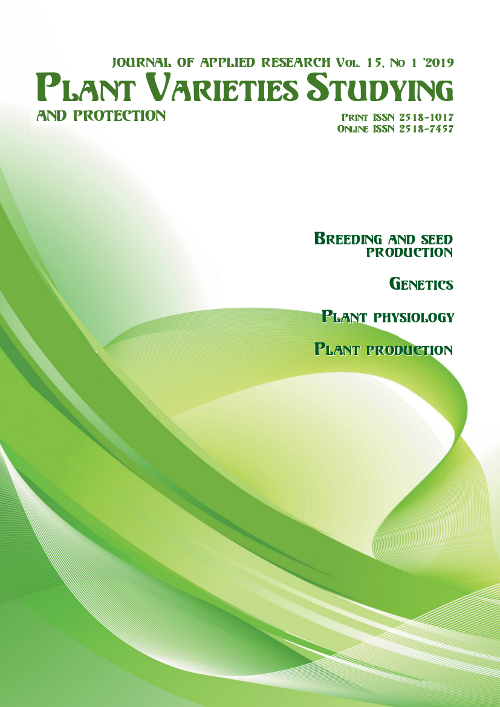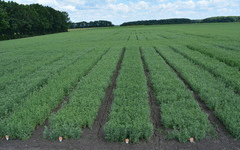Inheritance of wheat head productivity elements in F1 Triticum aestivum L. hybrids created on the basis of cultivars carring wheat-rye translocations 1AL.1RS and 1BL.1RS
DOI:
https://doi.org/10.21498/2518-1017.15.1.2019.162472Keywords:
soft winter wheat, variety, hybrids, wheat-rye translocations, elements of the spike productivity, inheritance, heterosisAbstract
Purpose. Investigate the inheritance of the elements of productivity of the main ear-head by hybrids of the first generation of soft winter wheat, obtained from crossing varieties that carry wheat-rye translocations (WRT) 1BL.1RS and 1AL.1RS.
Methods. Phenological, biometric, and statistical.
Results. The differentiation of the elements of the crop structure between F1 hybrids was revealed. In 2016, based on the results of the analysis of the main ear length of F1 hybrids overdominance was detected in 26.7% of them, partial positive dominance – in 10.0%; by the number of grains: overdominance – in 13.3%, partial positive dominance – in 10.0%; by weight of grains from the main ear: overdominance – 16.7%, partial positive dominance – 3.3%. In 2017, overdominance along the length of the main ear was determined in 36.7% of the first generation hybrids, partial positive dominance – in 10%; by the number of grains: overdominance – 46.7%, partial positive dominance – 6.7%; by weight of grains from the main ear: over-domination – 40.0%, partial positive dominance – 10%. In terms of breeding ‘Kolumbiia’ / ‘Ekspromt’ (1AL.1RS / 1AL.1RS) crossing was the most valuable by the combination of the length of the main ear and the grain weight of it, heterosis was observed in 2016 and 2017; ‘Svitanok Myronivskyi’ / ‘Lehenda Myronivska’ (1BL.1RS / 1BL.1RS) showed good results in combination of the number and weight of grains from the main ear. The combination of two translocations in the wheat genotype can act as an auxiliary genetic background that increases the adaptive properties of the genotype to stressful environmental conditions and provides a high and constant level of grain productivity. Conclusions. A different degree of inheritance of grain product elements in wheat hybrids F1 was revealed. Hybrid combinations F1, which provided overdominance and partial positive dominance of the length, number and weight of grains of the main ear from crossing carrier cultivars carring WRT were identified. In terms of breeding ‘Kolumbiia’ / ‘Ekspromt’ (1AL.1RS / 1AL.1RS) crossing was the most valuable by the combination of the main ear length and the weight of grains, ‘Svitanok Myronivskyi’ / ‘Lehenda Myronivska’ (1BL.1RS / 1BL.1RS) – in combination of the number and weight of grains from the main ear.
Downloads
References
Rybalka, O. I. (2012). QUO VADIS*, wheat selection for grain quality? Zbìrnik naukovih pracʹ SGI – NCNS [Collected Scientific Articles of PBGI – NCSCI], 19, 6–25. [in Ukrainian]
Derzhavnyi reiestr sortiv roslyn, prydatnykh dlia poshyrennia v Ukraini u 2018 rotsi [State register of plant varieties suitable for dissemination in Ukraine in 2018]. (2018). (as of October 09, 2018). Kyiv: N. p. [in Ukrainian]
Bakumenko, O. M. (2017). Kombinatsiina zdatnist sortiv pshenytsi ozymoi z pshenychno-zhytnimy translokatsiiamy v umovakh Lisostepu Ukrainy [Combinative ability of winter wheat varieties with wheat-rye translocations under the conditions of the Forest-Steppe of Ukraine] (Extended Abstract of Cand. Agric. Sci. Diss.). Sumy National Agrarian University, Sumy, Ukraine. [in Ukrainian]
Rybalka, O. I., Morgun, V. V., & Pochinok, V. M. (2011). Centric wheat-rye chromosome translocation 1RSm.1BL: genetic modification for use in wheat breeding for bread-making quality. Fiziol. Biokhim. Kul’t. Rast. [Physiology and Biochemistry of Cultivated Plants], 43(5), 371–375. [in Ukrainian]
Shestopal, O. L., Zambriborshch, I. S., & Topal, M. M. (2014) Haploproduction capacity of bread winter wheat genotypes in the presence of wheat-rye translocation in the genotype. Vìsnik Harkìvsʹkogo nacìonalʹnogo unìversitetu ìmenì V. N. Karazìna. Serìâ Bìologìâ [The Journal of V. N. Karazin Kharkiv National University. Series: Biology], 23, 53–58. [in Ukrainian]
Basalii, V. V. (2004). Pryntsypy adaptyvnoi selektsii pshenytsi ozymoi v zoni Pivdennoho Stepu [Principles of adaptive selection of winter wheat in the zone of the southern Steppe]. Kherson: Ailant. [in Ukrainian]
Bаhan, А. V., Yurchenko, S. О., & Shаkаlii, S. М. (2012). Changeability of posterity of different morphological parts of winter wheat ear according to quantitative signs. Vìsn. Poltav. derž. agrar. akad. [News of Poltava State Agrarian Academy], 4, 33–35. doi: 10.31210/visnyk2012.04.07 [in Ukrainian]
Dospekhov, B. A. (1985). Metodika polevogo opyta (s osnovami statisticheskoy obrabotki rezul’tatov issledovaniy) [Methods of Field Experiment (with the Basics of Statistical Processing of Research Results)]. (5th ed., rev.). Moscow: Agropromizdat. [in Russian]
Matzinger, D. F., Mann, T. J., & Cockerham, C. C. (1962). Diallel crosses in Nicotiana tabacum. Crop Sci., 2(5), 383–386. doi: 10.2135/cropsci1962.0011183X000200050006x
Fonseca, S., & Patterson, F. L. (1968). Hybrid vigor in a seven-parent diallel cross in common winter wheat (Triticum aestivum L.). Crop Sci., 8(1), 85–88. doi: 10.2135/cropsci1968.0011183X000800010025x
Griffing, B. (1950). Analysis of quantitative gene action by constant parent regression and related techniques. Genetics, 35(3), 303–321.
Beil, G. M., & Atkins, R. E. (1965). Inheritance of quantitative characters in grain sorghum. Iowa State J. Sci., 39(3), 345–348.
Downloads
Published
How to Cite
Issue
Section
License
Copyright (c) 2019 Ukrainian Institute for Plant Variety Examination

This work is licensed under a Creative Commons Attribution-ShareAlike 4.0 International License.
Starting in 2022, the copyright to the publication remains with the authors
Our journal abides by the CREATIVE COMMONS copyright rights and permissions for open access journals.
Authors, who are published in this journal, agree to the following conditions:
- The authors reserve the right to authorship of the work and pass the first publication right of this work to the journal under the terms of a Creative Commons Attribution License, which allows others to freely distribute the published research with the obligatory reference to the authors of the original work and the first publication of the work in this journal.
- The authors have the right to conclude separate supplement agreements that relate to non-exclusive work distribution in the form in which it has been published by the journal (for example, to upload the work to the online storage of the journal or publish it as part of a monograph), provided that the reference to the first publication of the work in this journal is included.

























 Ukrainian Institute for Plant Varieties Examination
Ukrainian Institute for Plant Varieties Examination  Селекційно-генетичний інститут
Селекційно-генетичний інститут Institute of Plant Physiology and Genetics of the National Academy of Sciences of Ukraine
Institute of Plant Physiology and Genetics of the National Academy of Sciences of Ukraine
 The National Academy of Agrarian Sciences of Ukraine
The National Academy of Agrarian Sciences of Ukraine